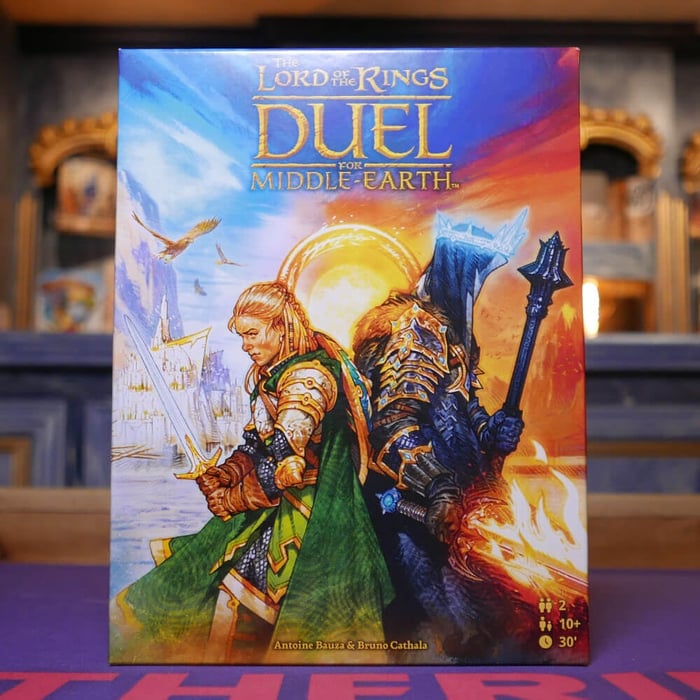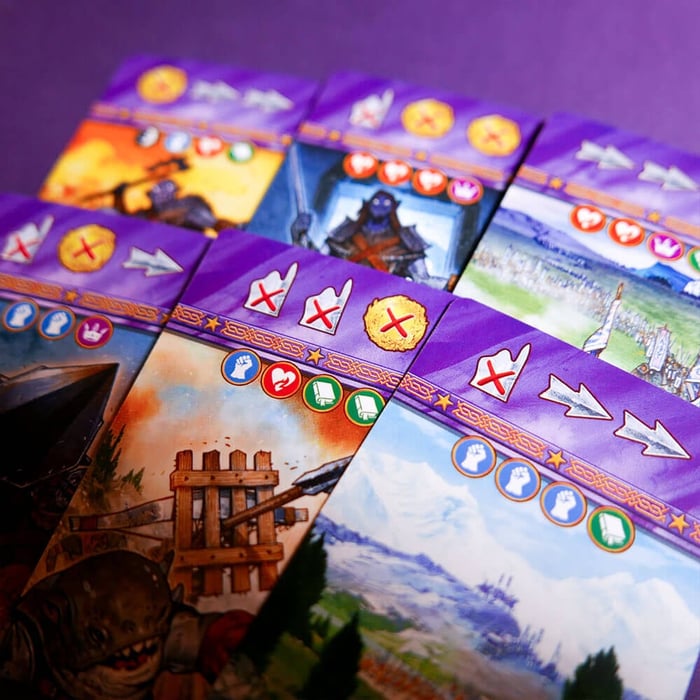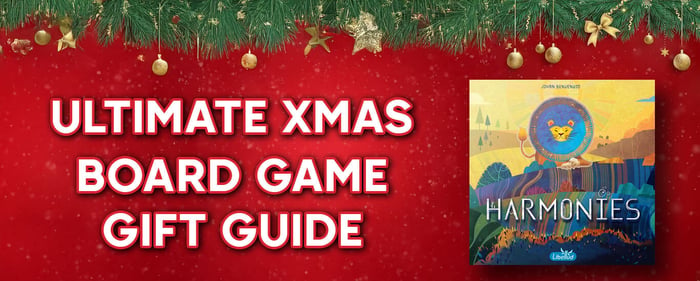When 7 Wonders: Duel met Sauron...
Table of Contents
Not Another Reskin
7 Wonders: Duel was released in 2015 and quickly became a respected and well-loved, head-to-head, 2-player, classic game. Designed by the same designers, Antoine Bauza and Bruno Cathala, Lord of the Rings: Duel for Middle Earth has attracted a lot of interest. Heavily inspired by 7 Wonders: Duel, it has left many asking the question, “Is this just the same game with a new skin?”. Lord of the Rings is an incredible IP, and many game designers have dipped their toes into the Tolkien universe, but this isn't just a cash grab. Repos Production has taken, quite frankly, a brilliant, fast-paced head-to-head game, building on some of the mechanics we know and love and have actually made it better. It is fair to say I love Lord of the Rings, so I am aware of my potential bias but I don't think I am alone in thinking this.
Before I talk about why I love Lord of the Rings: Duel for Middle Earth, let's have a look at the game in more detail.
 Lord of the Rings: Duel For Middle-Earth Board Game Box Art
Lord of the Rings: Duel For Middle-Earth Board Game Box ArtMechanics: 2-player, card drafting, tableau builder, area control, set collection, multiple win conditions, running away from Nazgul, nasty hobbitses
Players Count: 2
Play Time: 30 mins
Ages: 10+
Victory Conditions
3 Victory Conditions to Rule Them All
In LOTR: Duel for Middle Earth, there are three distinct ways to win.
Firstly, there is the ring track, which ends at Mount Doom in Mordor. For the Fellowship player, the goal is to move the hobbits and the ring along the track, winning the game upon reaching the end. The Sauron player’s ring wraith's goal is to catch the hobbits! This is represented in a lovely 2-layer slider with the Nazgul overlaying the hobbit track, which works well.
 The Ring Track: used to gain victory by completing the quest of the ring
The Ring Track: used to gain victory by completing the quest of the ringThe second victory condition is in the battle for dominance of Middle-Earth. In the middle of the table, you place a map board with seven regions represented. Throughout the game, you can take actions to place units and fortresses on to the board. If, at any point, one player has a presence in all seven regions, they win the game.
 The Map Board: used for a dominance victory
The Map Board: used for a dominance victoryFinally, you can win the game by holding an alliance with all six races in the game. This is achieved by collecting chapter cards representing all six races, at which point the game ends and you win.
 Race Cards: used for an alliance victory
Race Cards: used for an alliance victoryOnce you have achieved any one of the three victory conditions, the game finishes. Each of these conditions requires you to follow a different strategy, but will your opponent let you? Throughout the game, you will be competing for cards, enabling you to further any one of these three goals. However, the decisions your opponent makes can directly impact your plans. Which cards will they take, and what will they reveal? Will they use a card for coins just to enjoy the look on your face as you feel victory slip out of your grasp?
To understand the interaction between players here, let's have a look at the gameplay.
Gameplay
Furthering Your Plans, Constructing Chapter Cards
For anyone who has played 7 Wonders: Duel, the core mechanic of Duel for Middle-Earth remains faithful to the original game. The game is played over three successive chapters that each unfold in a similar way. The players take turns to take chapter cards from the table, which can be used in one of 2 ways: constructed for their effect or discarded for gold coins.
The challenge comes in the clever way the cards are set up. Each chapter starts with the chapter cards laid out in a pre-determined pattern of overlaying cards.
 Chapter 1 Cards Set Up
Chapter 1 Cards Set UpYou can only draw from the accessible cards, those that are not covered in any part by other cards. Some rows are face up, and some face down in the pattern, revealing to you limited information about the chapter cards on the table. This brings an interesting dynamic. As you pick up cards to further your strategy, you also need to be aware of what you might be uncovering for your opponent. Sometimes, the best strategy is not picking up the card you really want or removing a card your opponent does.
Each chapter has a unique, pre-determined pattern. For example, the first is a pyramid with six face-up cards along the bottom, and the second is the same shape inverted, starting with two face-up cards.
 Chapter Set Up Overview
Chapter Set Up OverviewThe Chapter cards have two key uses:
- Construct the building represented by paying its cost and gain the benefit.
Or
- Discard for a number of coins equal to the chapter number.
Card Types
Each card type provides a different benefit and feeds into your strategy to win:
Grey Cards
Grey cards have symbols representing the five different skills: Ruse, Courage, Strength, Knowledge and Leadership.
These skills are used to pay the cost for other chapter cards. For each symbol you have in your tableau, you gain one of that skill for each turn. If you do not have the skills shown on a card, you can still purchase it, paying one gold for every missing symbol.
 Grey Cards: used to pay the cost of other chapter cards
Grey Cards: used to pay the cost of other chapter cardsGetting a good spread of symbols early on in the game can make a huge difference to your ability to acquire chapter cards, especially in the 2nd and 3rd chapters, as cards become more powerful and expensive.
As the game progresses, you are also able to chain cards, meaning that you can pick up cards in a later chapter for free if you have the right chaining symbol on one of your cards.
Yellow Cards
Yellow cards provide you with gold coins from the reserve.
 Yellow Cards: provide gold from the reserve
Yellow Cards: provide gold from the reserveThroughout Duel for Middle-Earth, you are going to need coins to supplement your skills and pay additional coin costs found on cards and landmarks. Nothing is more frustrating than seeing the card you have been waiting for revealed only to have run out of coins.
Blue Cards
Blue cards take you further on your quest for the ring, whether that is carrying it to Mordor or helping you to close the gap on those halflings.
 Blue Cards: used to progress your quest for the ring
Blue Cards: used to progress your quest for the ring
For every ring symbol on a card, you move one space on the track. In addition to moving you towards your victory condition, the track unlocks bonuses along the way, such as gold coins or extra troop placements.
Red Cards
Red cards allow you to deploy units to the board.
 Red Cards: used to deploy units
Red Cards: used to deploy unitsEach card gives you a number of units and a choice of 2 regions. You have to make tactical choices as you acquire this card, looking at what other cards might be available. If you ever deploy into the same region as your opponent, it initiates a conflict in which each unit does one damage to an opponent's unit simultaneously until one or both players have no units left in the region.
Green Cards
Green cards represent the races of Middle-Earth and can be really powerful. Firstly, as already mentioned, if you ever get six symbols, one for each race, you win the game! The cards represent building alliances with the individual races, and if you pick up two matching symbols, that race provides you with a unique ability. This could be a triggered action when you acquire certain cards. One example of this triggers an additional turn whenever you play a yellow card. This could make a huge difference, enabling you to grab more gold and then pick up a more costly card in the same turn.
 Green Cards: used to form alliances
Green Cards: used to form alliancesThey could also do things like provide you with a wild skill each turn or provide you with a powerful one-shot action like removing an opponent's fortress from a region. There are 18 unique abilities, 3 in each race, triggered by these alliances, which means your strategies can change depending on which abilities you draw. However, you can target certain abilities if you acquire the right green cards.
Purple Cards
The final card type is manoeuvre cards, which are only present in the 3rd chapter. These bring a little more player-on-player interaction and enable you to manipulate the region board in the middle of the table.
 Purple Cards: used to make manoeuvres
Purple Cards: used to make manoeuvresSometimes, these cards will allow you to remove troops from the board, move your troops between regions or enable you to remove your opponent's gold. Manoeuvres can change the battle for area control, enabling you to move your presence on the board or neutralise your opponents.
Landmarks
Instead of using a chapter card on your turn, there is one final action you can take to purchase/construct a landmark. These are purchased in the same way as chapter cards but at a high cost. They also become more expensive with each fortress you build. Similar to the wonders in 7 Wonders: Duel, these might be costly but bring powerful, potentially game-winning benefits. In LOTR Duel for Middle-Earth, each region has one landmark that can be constructed from 3 available, drawn at random. When you construct a landmark in a region, it allows you to build a fortress there. These do not contribute to any combat but do count as you having a presence in a region. This can be significant when looking for a dominant victory. In addition to the fortress, they provide other bonuses as well. This could be adding troops to a region, moving on the ring track, gaining gold, etc.
 Landmarks
LandmarksIn my last game of Duel for Middle-Earth, I was able to win the game when I picked up a landmark that enabled me not only to build a fortress in a region where I had no troops but then also to move other troops. This enabled me to mark my presence in every region, much to the displeasure of my opponent! Although they can be easily overlooked, they make such a difference.
7 Wonders Duel vs Lord of the Rings: Duel for Middle-Earth
What's the Difference?
As I referenced earlier, this game is heavily influenced by its predecessor. It has kept what works well and introduced some brilliant new elements as well.
The most obvious of these are in the game objectives; both the game board and the ring track are new and very different. I think the area control board really upgrades the military element of the game. Previously, you had a military track, and with every red card, you effectively moved the token back and forth between you, trying to push it to the other end of the track. Duel for Middle-Earth brings in a really interesting area control game with basic combat, which really improves the game. The ring tracker effectively replaces victory point cards. This in itself is a significant change; there are no victory points in Duel for Middle-Earth. In 7 Wonders: Duel, the blue cards were just victory points for the end of the game, which was okay but not that interesting. Various cards scored you victory points, the wonders brought you victory points, and the purple cards in the 3rd age gave you new point-scoring mechanics. The victory conditions are simplified: no points but three distinct objectives to win. Some people might not agree with this,as they may have really enjoyed the points total victory condition. Duel for Middle-Earth is more about player interaction, competing for objectives and position, rather than a race for points. Personally, I think they have nailed this. I also think this means the choice of chapter cards becomes more important, especially in being careful about what you could leave open for your opponent when you take other cards.
The other key difference pertains to how you use the skills to purchase chapter cards. In Duel for Middle-Earth, if you do not have a skill required to purchase a card, it costs you one gold per missing symbol, but in 7 Wonders: Duel, there was a slightly more complicated mechanic. For every skill you were missing, it cost you one gold per matching symbol in your opponent's tableau. So, a brick could cost you an extra three gold per brick symbols if that's what your opponent had. This did bring a different strategy, almost enabling you to price your opponent out of certain cards if they did not have a good spread of symbols. I like the way they have simplified this in Duel for Middle Earth, but again, people could have differing opinions about this.
Another aspect they have slightly modified is the gold you receive for discarded cards. One gold for Chapter one, two for chapter two, etc. In contrast, in the 7 Wonders: Duel, this was based on how many yellow cards you had in your tableau.
Finally, although the faction cards fulfil a very similar win condition as the science cards in Duel for Middle Earth, the alliance tokens are slightly different to the progress tokens. Each faction has three unique faction abilities, and when you gain your second symbol of a chosen faction, you look at the top two tokens and choose one. This enables you to think ahead and target a specific faction. The Halflings have a token that represents a wild faction symbol, and if you are trying to achieve an alliance victory, this will bring you more opportunities to achieve six faction symbols.
Ultimately, Duel for Middle-Earth is a tighter game, simplified in some areas but in a positive way and in line with the theme, which is more of a conflict between two players than a race.
Final Thoughts
7 Wonders: Duel is an excellent game that I have owned for a number of years. In releasing Lord of the Rings: Duel for Middle Earth, Repos Production has taken a great game and made some really nice improvements. Duel for Middle Earth feels smoother as a game. It feels more focused on what you are trying to achieve. It retains the core mechanic based around the chapter cards and how the overlapping patterns you create during chapter set-up force clever decisions on which cards to take. Sometimes, the card you want might not be the best card to take, especially if it uncovers a significant card that would benefit your opponent. Other times, discarding a card that could help your opponent and bring you vital coins can make a huge difference. Thankfully, they have not lost just how good this interaction with the chapter cards is.
The components in Duel for Middle Earth are great as well. The introduction of the game board brings with it nicely designed wooden troops and fortresses. The ring track is a great touch with the Nazgul token sliding above the Fellowship tracker, which itself is sliding over the ring track. The art and card design is also excellent. This game delivers a lot for a really good price.
This is a game that I think will become a go-to game in my own collection for quick, strategic, well-designed 2-player games. Whether you are playing something big and need a warm-up or filler or just have time for a 30-minute game, Duel for Middle Earth will not disappoint. I would definitely recommend this game.
Score
9 out of 10
![]()
Pros | Cons |
| + Beautifully designed game | - Simplified mechanics might feel lighter to some |
| + Simple, strategic gameplay | - Removal of victory points may not be everyone's cup of tea |
| + Taken a classic and improved it | - Area control victory condition can become a focus/distraction |
| + Nasty Hobbitz | - No Gollum!! |
The Lord of the Rings: Duel for Middle-Earth

£22.99
£27.99
Description A dark rumour rises from Mordor. The Eye turns to Middle-earth. The hour has come. The Fellowship is reunited. The Heroes prepare for battle. In Duel for Middle-earth, you’ll have to choose sides. Play as the Fellowship of the… read more
If you are looking for a 2-player game but this one has not grabbed your attention yet, why not take a look at Run, a brilliant 2-player hidden movement game of cops and robbers that is so clever and fun to play?
If you are looking for a more cooperative experience, I really recommend Sky Team. Work together to land your plane, overcoming challenges, weather conditions and other planes along the way! This makes for a brilliant and unique game experience.
You can find more 2-player game recommendations in our 2-player game special blog post. We highly recommend taking some time to browse through our full collection of board games and strategy games here at Gathering Games and find one that catches your gaming eye.




